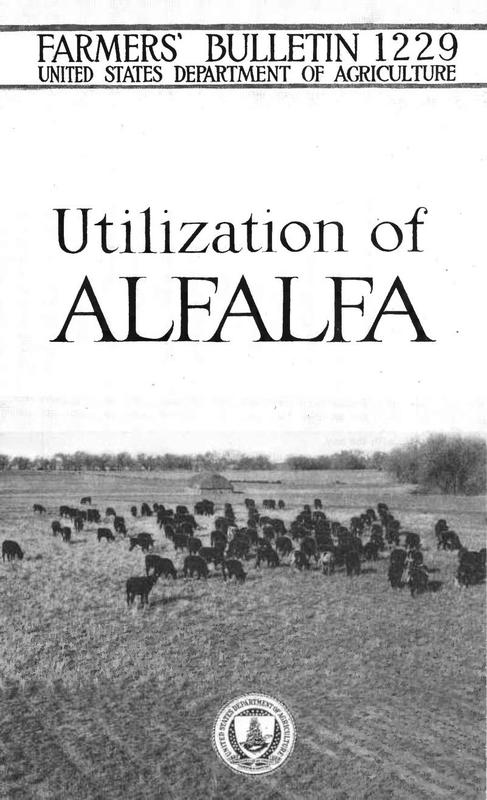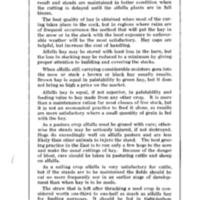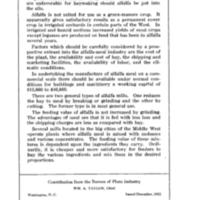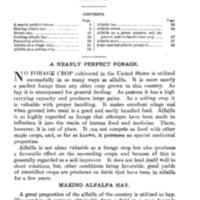Utilization of Alfalfa
Date
1921
Excerpt
HEREIN the uses of alfalfa are set forth, particularly its use as a forage crop, and suggestions are offered that may be helpful in making its utilization more efficient and more generally satisfactory.
Recent experiments indicate that larger yields of hay result and stands are maintained in better condition when the cutting is delayed until the alfalfa plants are in full bloom.
The best quality of hay is obtained when most of the curing takes place in the cock, but in regions where rains are of frequent occurrence the method that will put the hay in the mow or in the stack with the least exposure to unfavorable weather will be the most satisfactory. Hay caps are helpful, but increase the cost of handling.
Alfalfa hay may be stored with least loss in the barn, but the loss in stacking may be reduced to a minimum by giving proper attention to building and covering the stacks.
When alfalfa still carrying considerable moisture goes into the mow or stack a brown or black hay usually results. Brown hay is equal in palatability to green hay, but it does not bring as high a price on the market.
Alfalfa hay is equal, if not superior, in palatability and feeding value to hay made from any other crop. It is more than a maintenance ration for most classes of live stock, but it is not an economical practice to feed it alone, as results are more satisfactory where a small quantity of grain is fed with the hay.
Recent experiments indicate that larger yields of hay result and stands are maintained in better condition when the cutting is delayed until the alfalfa plants are in full bloom.
The best quality of hay is obtained when most of the curing takes place in the cock, but in regions where rains are of frequent occurrence the method that will put the hay in the mow or in the stack with the least exposure to unfavorable weather will be the most satisfactory. Hay caps are helpful, but increase the cost of handling.
Alfalfa hay may be stored with least loss in the barn, but the loss in stacking may be reduced to a minimum by giving proper attention to building and covering the stacks.
When alfalfa still carrying considerable moisture goes into the mow or stack a brown or black hay usually results. Brown hay is equal in palatability to green hay, but it does not bring as high a price on the market.
Alfalfa hay is equal, if not superior, in palatability and feeding value to hay made from any other crop. It is more than a maintenance ration for most classes of live stock, but it is not an economical practice to feed it alone, as results are more satisfactory where a small quantity of grain is fed with the hay.
Title
Utilization of Alfalfa
File(s)
Utilization of Alfalfa Cover.jpg
(image/jpeg)
Utilization of Alfalfa Summary.jpg
(image/jpeg)
Utilization of Alfalfa Summary 2.jpg
(image/jpeg)
Utilization of Alfalfa TOC.jpg
(image/jpeg)
 An official website of the United States government.
An official website of the United States government.





